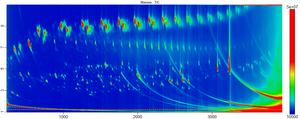The Flavour of Old Apple Varieties

CD Laboratory for Mass Transport through Paper

The aim of this project is to gain a fundamental understanding of the interdependence of transport mechanisms and the pore network of paper. Therefore, representative gases and organic compounds capable of gaseous transport are selected and measured to determine the pore network of paper and its transport-relevant properties. The used analytical techniques include migration cells and gas chromatographic based methods.
AuReLiA - Automated assessment strategy for recyclates in food contact - interdisciplinary approaches

Europe’s vision of a new circular economy regarding packaging materials aims to make all plastic packaging produced in the EU market reusable or recycled in a cost-effective manner by 2030. Subsequently, the development and deployment of highly efficient sorting procedures and recycling processes are needed to enable production of high-quality recycled products, as well as analytical strategies for their characterization and safety evaluation. The regulatory details were only lately published by the European Commission in its new regulation (EU) No. 2022/1616 on recycled plastic materials for food contact. It allows newly developed, non-authorized technologies and approaches, so-called ‘novel technologies’, to be deployed in the field and bring products to the market. One of the key points is to guarantee processes and materials that are safe to use for the consumer. This should be reached by comprehensive characterisation of the materials and processes. However, the regulation does not give a more detailed description on suitable methods and parameters for testing and monitoring of those. The main aim of this project is to develop an assessment strategy that generates the needed data for the approval of novel technologies and to guarantee consumer safety of the generated products for food contact according to regulation (EU) No. 2022/1616. Read more...
Analysis of Poly- and Perfluorinated Alkyl Substances
Poly- and perfluorinated alkyl substances (PFASs) have been intensively investigated in recent years because of their occurrence and importance in food packaging materials. PFASs are thermodynamically stable and highly resistant towards many forms of degradation. Their stability and water/lipid repellent properties makes them attractive for various applications, including in food contact materials (FCMs) of paper and board. However, these substances are also very persistent, bioaccumulative and toxic, and recently some PFASs have begun being regulated or phased out.
MOSH MOAH Reduction of Mineral Oil Contamination in Food
In the field of mineral oil contamination, significant progress has been made in recent years. Numerous sources of contamination throughout the production process have been identified, and the initial, often high levels (up to several grams per kilogram) in food have been reduced to just a few milligrams. In analytical chemistry, standardized methods with appropriate detection sensitivity have been developed.
Until now, however, it has been challenging to deduce potential health hazards from detected mineral oil contamination. Within the framework of this project, a comprehensive characterization using chemical analysis was combined with toxicological tests of the identified fractions for the first time. It was demonstrated that only certain aromatic mineral oil fractions - those containing three or more aromatic rings - exhibit mutagenic potential. This allows for a much more differentiated assessment of detected mineral oil contamination in food. During a screening of various machine oils, identified by industry partners in this project as posing a real contamination risk to food, it was shown that none of these oils needed to be classified as critical, as no DNA-reactive, mutagenic MOAH fractions could be detected.
Characterisation of Functional Barriers for Food Contact Materials


